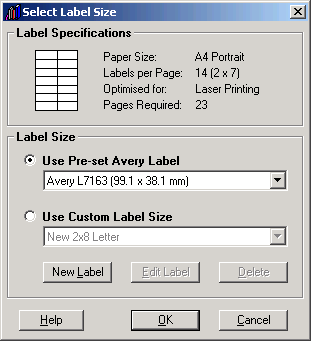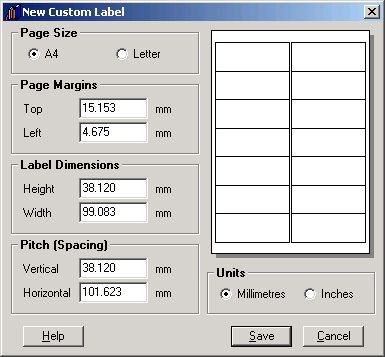
Libraries Directory Home • Online Guide • A to Z
 |
The Libraries Directory 50th Edition Libraries Directory Home • Online Guide • A to Z |
Selecting the Label Size • Customising Labels
The Libraries Directory application's mailing list facilities allow you to print out your mailing lists as address labels. You can select a wide range of different label sizes, or define your own custom labels.
To select the label size for your mailing, click the Select Label Size menu item or click the Label Size button in the Mailing Label Preview window. This will open the Select Label Size dialog:

| 1. |
You can select an existing pre-set label from the Use Pre-set Avery Label drop-down list, which includes a wide variety of standard Avery label types. You can also customise the selected pre-set label by clicking on the New Label button - this will open the Custom Label dialog, which will use the selected label dimensions as a template for a new custom label. |
|
|---|---|---|
| 2. |
Alternatively, you can select a customised label from the Use Custom Label Size drop-down list, although initially the list will be empty, until you create one or more custom label types. |
|
| 3. | To create a new custom label, select a label from either list to act as a template for the new label, and then click on the New Label button to open the Custom Label dialog. To edit an existing custom label, select the label you wish to modify, click the Edit Label button, and use the Custom Label dialog to modify the label margins and dimensions. To delete a custom label, select the label you wish to remove, and then click on the Delete button. Please note that pre-set labels cannot be edited or deleted. To customise a pre-set label, you should create a new custom label using the pre-set label as a template. |
Each time you choose a label type (pre-set or custom), the dialog will display the paper size, the number of labels per sheet, and the printer type for which the labels are optimised, along with the number of sheets required for each copy of the current print job. You can also click on the preview icon to cycle through the items in the selected list one at a time.
N.B. Although the application supports 2x8 label sizes (16 labels per page) and allows the creation of custom labels of anything up to 4x10 (40 labels per page), you may find that the longer addresses will not always fit onto smaller sized labels. For this reason, it is recommended that you use a label size larger than the minimum supported (e.g., 2x7, with 14 labels per page) when printing addresses. However, the application does feature an Optimise Problem Addresses facility which attempt to adjust overrunning addresses so that they fit within the existing label dimensions.
To open the Custom Label dialog, select a pre-set or custom label in the Select Label Size dialog and click on the New Label button (to create a new custom label using the selected label as a template) or select an existing custom label and click on the Edit Label button (to edit the selected label):

You can specify the following settings:
| 1. |
Page Size - Two pre-set options are available, A4 and Letter. |
|
|---|---|---|
| 2. |
Page Margins - The Top Margin is the space between the top of the page and the upper edge of the first row of labels. Increase the Top Margin to move the labels downwards on the page, and decrease it to move the labels up the page. The Left Margin is the space between the left-hand edge of the page and the left-hand edge of the first column of labels. Increase the Left Margin to move the labels to the right of the page, and decrease it to move them to the left. |
|
| 3. |
Label Dimensions - The Height and Width of the individual labels. Use these values to adjust the size of the labels. |
|
| 4. |
Pitch (Spacing) - Use these values to adjust the spacing between the labels. The Vertical Pitch is the distance between the upper edge of one row of labels and the next, and is equal to the height of the labels plus any vertical space between them. Increase the Vertical Pitch to increase the vertical spacing between the labels, and decrease it to reduce the spacing. The Vertical Pitch can never be less than the label height. The Horizontal Pitch is the distance between the left edge of one row of labels and the next, and is equal to the width of the labels plus any horizontal space between them. Increase the Horizontal Pitch to increase the horizontal spacing between the labels, and decrease it to reduce the spacing. The Horizontal Pitch can never be less than the label width. |
|
| 5. | Units - You can choose to work in either inches or millimetres. Select the unit of measurement you prefer. Specifications for Avery labels are usually given in millimetres. |
As you make your changes, the preview display automatically updates itself to show you how your labels will look on the printed page. Note that adjusting some settings may lead to changes in others, in order to maintain consistency and to keep the label dimensions within the confines of the page.
N.B. When printing labels, it is always advisable to print a sample page to ensure that the labels are printing out correctly. If you find that the addresses are misaligned with the labels, then you can use the Custom Label dialog to adjust the Top and Left Margins in order to compensate.
See Also

About the CD-ROM
Creating and Managing Mailing Lists
Previewing and Printing Mailing Labels
The Mailing Label Preview Window
James Clarke and Co Ltd
PO Box 60, Cambridge, CB1 2NT, England
Tel: +44 (0) 1223 350865 Fax: +44 (0) 1223 366951
email: publishing@jamesclarke.co.uk